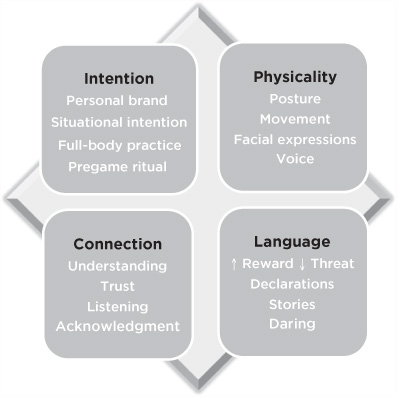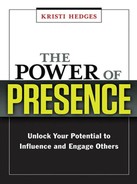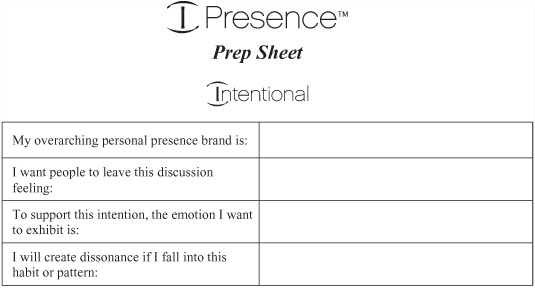CHAPTER 13
Bringing It All Together: Presence in a Pinch
So here we are at the conclusion of the book. And here you are, ready for an important meeting where you’ll be presenting your ideas about a new program at your company. You want to come across at your most compelling, confident, and authentic best.
How can you condense 200+ pages of ideas from this book into the 30 minutes you’ve set aside for preparation for your next meeting or event? I’ve got you covered. This chapter is for you.
As we head toward the finish line, let’s reflect back on the three-step I-Presence model: intentional, individual, and inspirational. Did you notice that the model moves from inward to outward? That’s exactly how presence works. It starts with you, builds through your connection to others, and ultimately catalyzes through your communications. Each piece is important on its own, and it is the combination that catapults leaders to a new level.
As we have learned from neuroscience, if people don’t act on new learning quickly and in workable increments, it is far less likely that they’ll achieve sustained behavior change. I want to keep these concepts alive for you so that even during the most stressful day, when you are focused on a dozen action items, you can show your strongest and best presence as you lead and inspire others.
So, in this wrap-up chapter, I’m creating “crib notes” that provide a quick recap of salient points from the book. Use this chapter as an ongoing reference guide—what I call the I-Presence Prep Guide— an in-the-moment overview that you can come back to before your next big meeting, presentation, or important conversation. At the end of the chapter, I’ve also included a brief questionnaire that may be helpful as a “presence practice sheet.” Now, let’s go through each element of the Prep Guide (see Figure 13-1) as a reminder.

Figure 13-1. I-Presence Prep Guide.
Prepare with Intention
Whether you have 30 minutes or 30 days to prepare, always start with intention. Everything flows from it. Consider intention your strategy, or the part you can most easily affect ahead of time so that you’ll have less to worry about during your event. Spend time preparing with intention and you’ll be more likely to stave off anxiety, distracting body language, lack of clarity, and other factors that can derail your presence. You may think this is the easiest part to skip when you are pressed for time. But it’s actually the most critical.
Personal Presence Brand. Your personal presence brand is what you want to be known for in general terms. It is the image that’s readily connected to you when people mention your name, whether inside or outside the company. A personal presence brand is relatively static and underscores your values and aspirations. You should be able to condense your brand down to just two or three words (e.g., “motivating and visionary,” “credible, caring catalyst,” or “change agent”) and carry it with you at all times. All intentions and the majority of your actions should enhance your personal brand, not detract from it. In this way, it becomes a personal guide for making decisions about what you say, where you go, and what you’ll do when you get there.
Situational Intention. This is like a swing thought—the last thing that goes through your mind as you hit the golf ball off the tee. Your situational intention is what you want to impart in a particular event that is unique to the situation. Here’s a simple way to consider it: As people leave your presentation, what do you want to hear them chattering about? Remember that humans process information on emotional terms. So whatever you want people to feel, you must first embody. If you’d like the reaction to be “excited and optimistic,” then you need to display those very qualities. “Excited and optimistic” therefore becomes your situational intention. (To map your main talking points to your situational intention, use the Intentionality Frame, as described in Chapter 1.)
Full-Body Practice. When we are relaxed, there’s a natural alignment between our minds and our bodies. We can sense a misalignment when we stop to take notice. Practice by simulating the actual event as much as possible. Say your thoughts out loud while either standing or sitting; in other words, practice the way you’ll be making your presentation. In this manner, you create muscle memory for your words and your body language. When you’re in the moment and anxiety kicks in, you’ll have a frame of reference that will make the experience more intuitive. If you don’t have time to practice your full presentation out loud, rehearse your opening remarks and the major points you need to make.
Pregame Ritual. A pregame ritual gets you in the zone for your event. It’s meant to stimulate the feelings you need to embody, allay nerves, and keep you focused. Everyone’s pregame rituals are different: Try cranking up a favorite song or joking with a friend, or practice deep breathing or even quiet contemplation of your intention. It doesn’t matter what your ritual is. Just find one that works and make it a repeatable practice.
Align Your Physicality to Your Intention
Hopefully you’ve rehearsed and have a strong sense of how you want to appear when you take the stage (literally or otherwise). Remember the three-part body check: face, gestures, and posture. Try to sense alignment with your intention in each of these domains as you go, and tweak them as needed. Don’t worry about perfect form. Instead, focus on what felt right to you naturally, in your relaxed state. And keep in mind that impressions are built over time—even if that time is only 15 minutes! A few distracting movements will not curtail an otherwise effective presentation. Chances are you’ll notice more of your missteps than anyone else will.
Posture. It is the first aspect of body language that we notice. That’s why we want to scream at the slumped-over teenager, “Straighten up!” For any executive, posture should be strong, with shoulders back and head up. Whether sitting or standing, notice if your stance is open or closed. Unless your intention is to ward off an unscrupulous salesperson, then your arms should be open with both feet planted on the ground. Be mindful of a common posture default: closed arms and crossed legs. Even when its purpose is to conserve heat in an overly air-conditioned office, this posture communicates defensiveness.
Movement. Any movement or gesture that you normally make is fine as long as it does not distract from your intention. As you practiced, you may have developed assured gestures to emphasize certain points. Perhaps you walked around to keep energy up. Repeat that movement in your presentation. When I’m speaking, I like to come out from behind the podium and even go into the audience to increase my connection to others. Yet for some people, that may not feel natural and could increase nervousness. If that’s the case, don’t worry about it. Instead, use your body check to avoid distracting, unintentional gestures such as toying with a pen, playing with your hair, or gripping the podium for dear life.
Facial Expressions. Nearly all professionals need to smile more. It’s the easiest way to have a more gracious, approachable presence. Body language and mood have a circular effect, so not only does a positive intention create positive body language, but the reverse is true as well. Smiling helps to solidify a positive intention. Unless the situation you are addressing is grave, remember to smile. If you can’t remember, write reminders in your notes.
Voice. Strong leaders speak with certainty and confidence. The tone of your voice creates perception. Tape-record yourself while you are talking and then replay it to gain valuable insight on how you sound to others. Speaking in declarative terms—“We will,” not “We might”—shows a self-assured presence. Caveats are not inspiring. Also, learn to be comfortable with pauses. First, pausing is quite natural for listeners because it allows them to get ready for your next point. Second, a pause allows a speaker time to collect his thoughts. It’s fine even to pause and lose track for a second, as long as you come back strong. (Others won’t know if it was intentional or not.)
Find the Connection Points
Whether your audience is one person or 1,000, their acceptance of you is largely based on their connection to you. In those presence-defining moments when we need to present ourselves, it’s common to focus on being perfect. We spend most of our energy developing the perfect words that we try to communicate in the perfect way. There’s certainly a level of competence and clarity to meet, but it’s just one part of how others assess your presence. Perfection can be alienating. Connection is about finding the humanity in others. If you want to strengthen your presence, consider how to foster trust and empathy. For many of us, this requires attention and deliberation.
Understanding. Understanding is a major piece of empathy—one that starts before you even enter the meeting room. Know your audience. Before you present, find out what their concerns are and if there is any relevant history. With small audiences, learn about their personal backgrounds. The more valid information you have, the more you’ll be able to address the concerns in the room. Go into a conversation assuming you don’t have all the information and seek out others’ perspectives. This can be an effective way to connect with even a large audience. Tell them what you understand about their situation, and then ask for their comments, which should provide greater detail.
Trust. Trust is foundational to presence. Your communications will not get through as intended unless you can establish trust. Human beings constantly assess one another as “friend or foe.” When trust is absent, we place the other person squarely in the foe category. We literally process a foe’s words in a different part of our brains than we do a friend’s! As you recall from Chapter 6, the components of the trust equation are credibility, reliability, intimacy, and self-orientation. As you prepare your comments, consider how you are touching on each of these components and building trust.
Listening. While listening sounds obvious and easy, it’s often absent when it counts the most. One of the best ways to increase connection is to become a great listener. Focus on the person in front of you, ask open-ended questions, clarify and rephrase, and curtail your own opinion. Whether it’s during an open Q&A or behind a closed door, true listening conveys empathy to the other person, and as a nice byproduct, you may just learn something new.
Acknowledgment. Workplace presentations, especially those involving new ideas and change, can become tense with so much at personal stake for the players. Acknowledgment is one way to keep everyone on the same side of the table. It’s the ability to say “I can see your position,” even if you don’t agree with it. It boosts empathy and changes the interpersonal dynamic. It strengthens your presence because it shows confidence in remaining open to opposing viewpoints. Much of a leader’s work is gaining buy-in, which requires others to feel heard and considered.
Use Language to Inspire
Leaders need to inspire and motivate to create followership. A core part of a leader’s job is to cultivate change on individual and broad scales. The study of neuroscience teaches us about the fundamental human reluctance to change and how to overcome it by helping people form ideas, focus on solutions, and act on moments of insight. Setting a compelling vision through language is a key part of managing change. Even the best vision is meaningless if it can’t be communicated and received clearly.
Increasing Rewards/Minimizing Threats. When presenting any information that hints of change, you’ll have the best reception if you consider the universal triggers that cause defensive reactions in others: threats to status, certainty, autonomy, and fairness. As much as possible, assure people on each of these fronts.
Declarations. Declarations are bold, assured statements that attract energy. They open up new possibilities. In a corporate world dominated by CYA behavior, when you make clear declarations—“I/We will do X”—people sit up and take notice. Successful leaders use declarations to move people, create excitement, show courage, illuminate a company’s raison d’être, and invoke change. Incorporate them where you can. And remember, if you fall short, be accountable; use the opportunity to learn and keep moving forward.
Stories. The human brain has evolved to process stories efficiently. That’s because for much of our time on the planet, stories provided vital information for our very survival. We enjoy telling and hearing stories. So, find ways to bring your own stories into your communications. Stories help people to know you and understand your values—and that increases trust. Stories are memorable. They aid in understanding complex concepts. And you are your most authentic when you are telling a story. The best stories are to the point, contain common reference points, and show struggle and achievement.
Daring. Part of a compelling presence is being interesting. As a leader, you are often in the spotlight, so it benefits everyone if you learn to play on a bigger stage. Be a visionary by cultivating an aspirational vision that’s personal to you, and share it actively. Dare to divulge opinions, bold stories, or a controversial stance on an issue. When you have to present, contemplate how to be different rather than one of the pack. Having a presence with a bit of shock value can be a good strategy.
Ready to Bring Your Best Self
At the beginning of this book, I discussed how much interest executive presence generates in companies today. Yet paradoxically, it’s difficult for the average professional to focus on it. Presence does seem personal, nebulous, and hard to execute. My hope is that I’ve taken some squishy concepts and helped them to take shape for you. I want you to be excited about your own ability to affect your presence in a way that will make your goals imminently achievable. In fact, it’s not all that hard. It just takes focus. Use the questionnaire in Figure 13-2 as a “practice sheet” for focusing on your own I-Presence.
Remember, as you head into that all-important meeting, you already have every ounce of presence you need in various parts of your life. All you are doing is integrating them to present your best self—your strongest presence—more purposefully and frequently. Don’t try to be perfect. It’s not about using every best practice you’ve ever learned or reshaping your personality.
Set an intention, go with what’s authentic for you, and wow them.
Wish I could be there.

